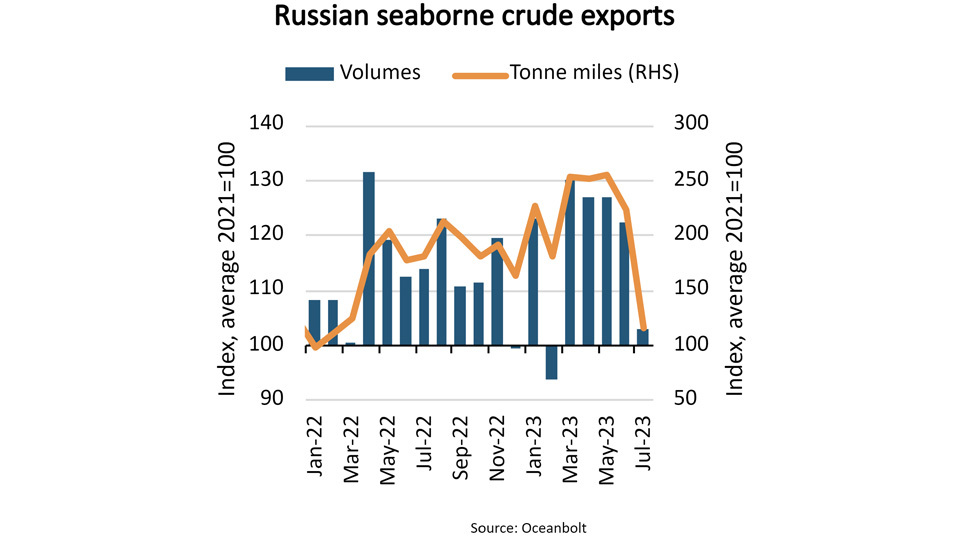Russian seaborne crude oil export volumes fall 16% m/m and may fall further
An even more important factor for the crude tanker market is how EU regulations have reshaped crude trades. China, India, and Türkiye have replaced EU countries as the main buyers of Russian crude oil, resulting in average sailing distances increasing 80-90% and significantly increasing tonne miles and demand for crude tankers.
The declining volumes in July again brought new changes to the destination split. India has recently taken 32-38% of the Russian export volumes but in July took only 12.5%. Instead, especially Türkiye and Egypt have increased their share.
The changed destination split means that the average sailing distance for Russian export volumes fell 38% m/m in July and ended 30% lower than July last year. Therefore, tonne miles of the Russian July exports fell 48% m/m and 30% y/y.
The Russian administration has announced that exports in August will be reduced by 500,000 barrels per day to support oil prices (approximately 2.1 million tonnes). Seaborne export volumes fell 3.3 million tonnes in July, and it remains to be seen whether the announced reductions will be in addition to the July reduction. If exports fall further, August volumes would end near 15 million tonnes, a level last seen in September 2021.
Despite the decrease in Russian export volumes, an increase in particularly Iraqi and Brazilian exports meant that global crude oil export volumes overall increased 3% m/m in July. However, the changes in origin and destination patterns had a significant effect on average sailing distances, and we estimate that tonne miles fell 15% m/m.
It appears that the reduction in Russian crude oil export volumes will last for a while, and it may also take a while before average sailing distances recover. Indian refineries are undergoing maintenance and the monsoon has brought lower demand. Considering the lower demand, and that the price for Urals crude has recently breached the G7 price cap, some owners may therefore exit the Russian business despite the premium freight rates available.
Feedback or a question about this information?
BIMCO's Shipping number of the week
- Brazil’s import of Russian clean petroleum products jumps 135%
- Iron ore shipments up 3.8% despite weak Chinese demand
- COVID pandemic wiped 24.6 million TEU off container market growth
- EU tanker import tonne mile demand up 12% as ships avoid Red Sea area
- Demand shocks drive ship recycling to lowest level in 20 years
ELSEWHERE ON BIMCO
Contracts & Clauses
All of BIMCO's most widely used contracts and clauses as well as advice on managing charters and business partners.
Learn about your cargo
For general guidance and information on cargo-related queries.
BIMCO Publications
Want to buy or download a BIMCO publication? Use the link to get access to the ballast water management guide, the ship master’s security manual and many other publications.




